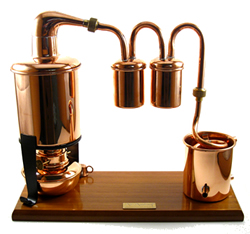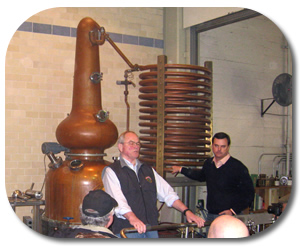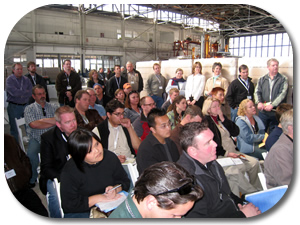 Most people aren’t familiar with the American Distilling Institute (ADI), an organization dedicated to furthering the cause of craft distilling in the US. The Institute allows smaller distilleries – both new and old – to cooperate and share information, to help further the science of distilling, and to (hopefully) continue the evolution of American Spirits.
Most people aren’t familiar with the American Distilling Institute (ADI), an organization dedicated to furthering the cause of craft distilling in the US. The Institute allows smaller distilleries – both new and old – to cooperate and share information, to help further the science of distilling, and to (hopefully) continue the evolution of American Spirits.
Every year, ADI holds a conference for its members, with a changing focus from conference to conference. For 2009 the Institute chose Brandy as their primary focus, but as I discovered in attending the conference, there was a lot more going on than putting wine into a still.
For three days (from April 5th through April 7th) distillers from all over the country gathered at St. George Distillery in Alameda (where St. George Absinthe, Hangar One Vodka, and quite a few other spirits are made) to discuss a broad range of topics. Most of the topics were brandy-focused, including the differences between California wines and French wines and the resulting difference in distillation techniques (the warmer climate of California creates grapes with much more sugar, so the fermentation and distillation processes have to take that in to account). Other sessions focused on the general science of distillation – from still types to gas chromatography for monitoring when to make the “cuts” on the distillate – as well as marketing and distribution of the spirits and the challenges faced by the small-batch, craft distiller.
 A great deal of the sessions ended up going completely over my head. I don’t have a degree in chemistry or distilling, nor do I spend a lot of time growing grapes or sugar cane. I did, however, get a good feel for the amount of hard work that goes in to creating every small batch spirit. Some of the attendees were fairly large and well-established (like Hangar One), while others were distillers that had yet to open their doors and release a single product. One thing that seemed to be shared by all of the attendees was a great passion for what they do and what they want to create – as well as a great willingness to help each other find their way to achieve their goals.
A great deal of the sessions ended up going completely over my head. I don’t have a degree in chemistry or distilling, nor do I spend a lot of time growing grapes or sugar cane. I did, however, get a good feel for the amount of hard work that goes in to creating every small batch spirit. Some of the attendees were fairly large and well-established (like Hangar One), while others were distillers that had yet to open their doors and release a single product. One thing that seemed to be shared by all of the attendees was a great passion for what they do and what they want to create – as well as a great willingness to help each other find their way to achieve their goals.
In addition to the sessions dispensing chemical formulas and temperature guidelines and fruit varietals that were all fascinating in that “I wish I were a distiller so that this would all make sense” sort of way, the members of the ADI spent time discussing distribution and marketing. The sessions and group/private conversations included the need to be cognizant of the mixological aspects of your product, as well as why it’s important to focus on your locality first, and to establish personal relationships with local restaurants, bars, and liquor stores. There were even discussions about how to best utilize well-known and influential bloggers in the spirits and cocktails community to generate better awareness of your brand.
 In the end, the sense of comraderie and community at the conference was overwhelming. While I’m certain not everyone loves everyone else’s brandy/whiskey/rum, they were all very helpful and encouraging to one-another. There is a good chance that we are witnessing a renaissance in American distilling. Much like the craft-brewing hobbyists have revitalized the American beer culture, so too are these enterprising craftsmen (and women) leading the way to a cornucopia of new and interesting spirits.
In the end, the sense of comraderie and community at the conference was overwhelming. While I’m certain not everyone loves everyone else’s brandy/whiskey/rum, they were all very helpful and encouraging to one-another. There is a good chance that we are witnessing a renaissance in American distilling. Much like the craft-brewing hobbyists have revitalized the American beer culture, so too are these enterprising craftsmen (and women) leading the way to a cornucopia of new and interesting spirits.
Tags: events, distilling, adi

Comments on this entry are closed.
The Concierge
Dood, For the few of us who don’t do our own home distillation, if you have it, can give us some information on the top few inspiring/standout projects from the attendees that are in the works? Which of those american distillers will have the most impact on what we see in our glasses?
Matt Robold
Well, one thing I should point out is that craft-distilling is not the same as craft-brewing. Craft brewing can be done at home by anyone. Home distilling is 100% illegal in the US. I do not distill alcohol at home, nor do I encourage the practice for others.
The craft distillers at the ADI conference are small commercial concerns that are fully-licensed and regulated by the Federal and State Authorities responsible for such things.
The interesting things coming out of the smaller-batch distilleries come in the form of greater artistry and craftsmanship put in to their current products than you typically see in larger commercial enterprises. Not that the majors are incapable of producing great products, but the larger distribution requires greater efficiency in production methods, which rules out a lot of the methodologies that provide more flavorful and interesting spirits.
I think the smaller distilleries are bringing improvements to copper still designs and the practices in using those stills. In terms of the spirits produced, I think you’re going to see more and more spirits that take chances. Not random, odd flavor choices, but bolder flavors that will provide mixologists and tipplers with a great deal of variety with which to play.
Helen Gagne - how to make hemp b
Thanks for giving a clear picture about home distilling. I was in search of this information for long. Great that I ended up here to understand the details.
list suggests
1960 live causes uncertainty routes